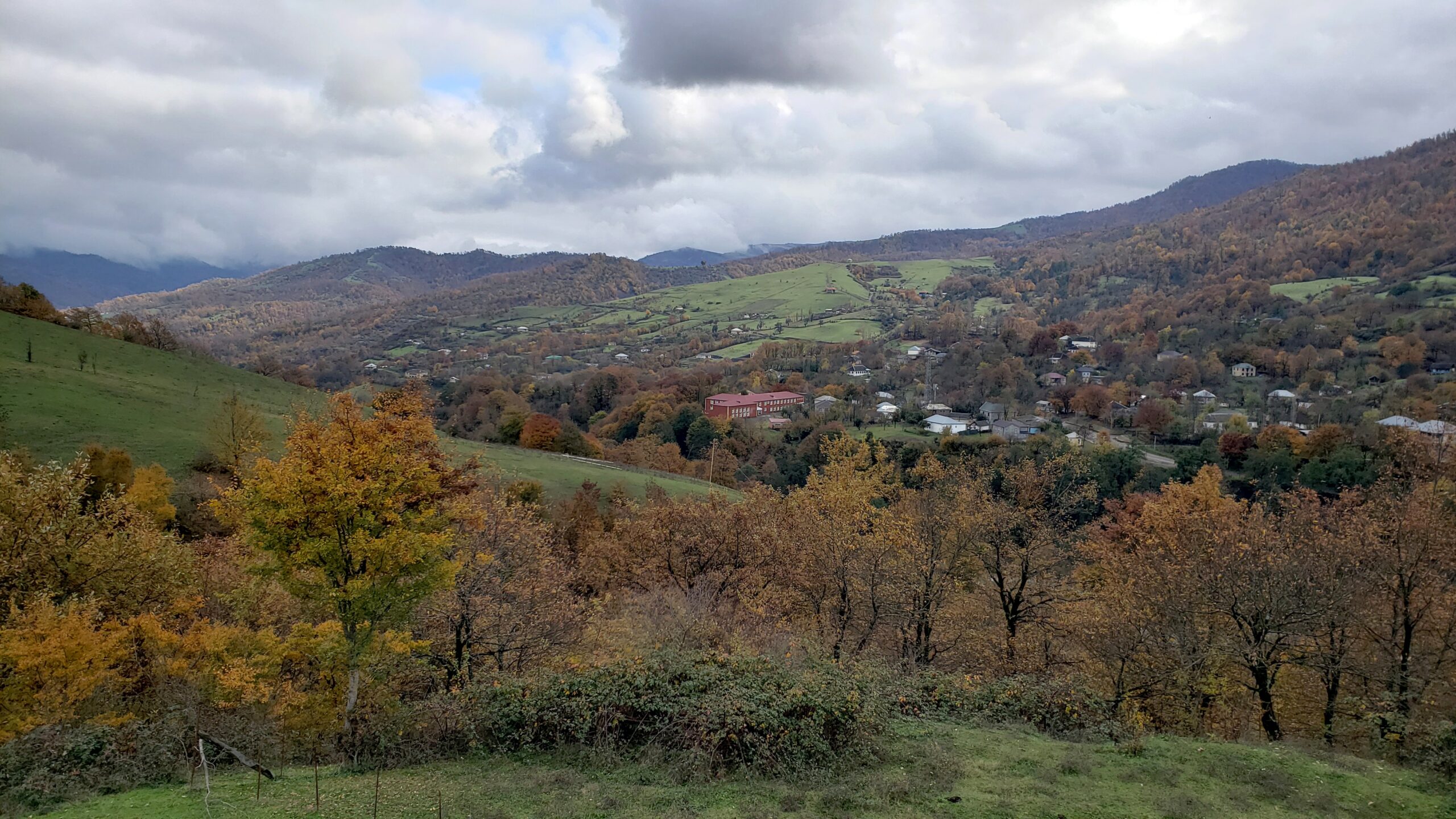In brief: We didn’t actually shift around in time, but rather found in southern Azerbaijan, at the edge of Iran, a forest surviving from ice ages past and a people who perhaps have the key to a long life.
Into the woods
It was the day after Thanksgiving, a busy social day in the United States, a time for celebrating peacefulness, even if that often seems tough to reach.
On that day we shared a bit of recent tranquility, our visit to the UNESCO-recognized Hyrcanian forests of Azerbaijan and Iran at the southern end of the Caspian Sea. The region’s name, “Hyrcania,” literally means “wolf-land.” Scattered within this sub-tropical region of ancient deciduous woodland, villagers have cleared spaces for their farming but remain in harmony with its rich diversity. Just visiting the forest made us serene.
A clearing in the woods during a foggy walk
Forest and farms in autumnal stillness
In the heart of the woods and the colors
A glorious bit of forest splashed with yellow
Remarkable striations along a sheared cliff show the slow accumulation of eons
Another section of forest and farms
A breathtaking viewpoint near Lerik
The long-lived Talysh
The Edenic natural beauty of the Talysh Mountains, that surprisingly verdant mix of deciduous forest and farmland near Iran, attracted us here. But could this also be Shangri-La?
It certainly wasn’t a Himalayan challenge to drive into the lush mountains. Its main town Lerik, at only 1100 meters (3700 feet) in altitude, seemed typical of Azerbaijani villages except for its verticality, the roads that swept up and down its steep hills. As in Shangri-La, though, people here seem to live a long time, a very long time, often a very, very long time.
The assertions about the actual ages have been disputed, but the prescription for a long, healthy life fit the region. That recipe includes daily physical activity to challenge the body, good nutrition from farm products and spring water rich in minerals, plus living at altitudes, which may decrease the risk of heart disease, stroke and diabetes.
At the museum that celebrates the region’s many centenarians, we felt a bit young by contrast, yet were welcomed like honored guests. And surely tempted to stay a long, long while.
The main room of the museum presents photos, proofs, and personal tales about many who exceeded 100 years in age. The beautiful woman on the far right, Shefiyeva Sarabanu Mammadgulu, born in 1900, reached 107 when she died in 2007. The only thing we could read at the museum was a narrative by some noted French visitors talking about their experience in meeting a few centenarians back when the travel here was more difficult.
When he died in 1973, Muslumov Shireli Ferzieli was said to be 168 years old, a record to which many locals and doctors testified. It’s exceeded only by mythic figures in sacred books like the Bible. A large display just as you enter the main room of the museum celebrates this Methuselah among men.
While we toured the hall of these impossibly aged people, we were reminded of a famous TV ad by Dannon Yogurt in the late 1970s. That promotion turned a niche product into a blockbuster one by touting the longevity of residents in the Caucasus.
In a syllogistic argument, the ad associated yogurt with very long living. The piece ended with an 89 year old man who ate two cups of Dannon Yogurt. Panning to the woman standing next to him, the ad ends, “That pleased his mother very much.” She was 114.
When we looked it up, the area featured was Abkhazia in Georgia, but the yogurt must have great powers across the Caucasian Mountains.
Ironically Dannon transformed a healthful product into a high sugar one containing lots of jam. No wonder the old guy liked it.
Many of the photos show the centenarians holding their passports or birth certificates as proof of vintage. This woman, born in 1870, died at 134 in 2004. This has to be Shangri-La, we kept thinking.
Our favorite photo in the museum was the old-timers gathering for a laugh. At first we wondered what would still make these guys guffaw after all their years. But then we thought, perhaps it’s the laughter, not the yogurt, that keeps them young.
Among the centenarians, you’re also never too old to master a new skill. Aghayev Macid Oruc (1835 – 1978) turns the focus of his Rolleiflex camera back on the photographers sometime before he died at age 143.
During our visit, a very friendly attendant tried to explain some things to us with little success. It turned out that the locals here speak Talysh, an Iranian language that you won’t find in Translate.
We managed to communicate a bit in Russian, a holdover from the old Soviet days, but missed pretty much all of what she was trying to tell us.
She even phoned someone for help, but communicating with the young man who showed up wasn’t any easier. We did understand the request for “rubles” as a contribution – and the glee they expressed in capturing a group photo before we left.
(To enlarge any picture above, click on it. Also, for more pictures from Azerbaijan, CLICK HERE to view the slideshow at the end of the itinerary page.)


















